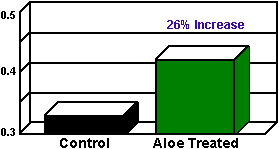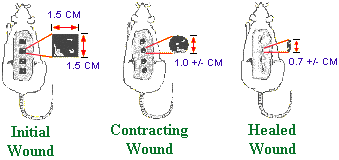Aloe And Other Topical Antibacterial Agents
| ||||||||||||||||||||||||||||||||||||||||||||||||||||||||||||||||||||||||||
 |
| Figure 2 Tissue culture response to Aloe 1:1 gel compared to control (untreated). |
Results
The SDS PAGE analysis revealed a high molecular weight polypeptide in Aloe vera 1:1 gel #5.The rat adrenal cultured cells in the presence of Aloe vera gel #5 showed a 26% increase in growth activity when compared to the control (Fig. 2). Therefore, we utilized the Aloe vera gel #5 for our in vivo assay.
Acute Wound Healing
Topical application of each therapeutic agent had a profound effect on the healing process. Overall healing rates of all the treated groups were significantly different as compared to the control group (p<0.05). The Aloe group had the shortest half-life, and healed faster than the control group (Table I). All the other treated groups had longer half-lives compared to the control group. While silver sulfadiazine with Aloe significantly increased the breaking strength (2.000 + 0.504) of the healed wound, Aloe alone was slightly stronger than the control silver sulfadiazine.| Table I Fractional Area & Healing Rates of Wounds Treated With Topical Antibacterials |
||||
|
|
(n) |
Area Throughout + SD |
Rate (Slope +SD) |
|
| 1. Control |
|
|
|
|
| 2. Aloe |
|
|
|
|
| 3. SSD |
|
|
|
|
| 4. SSD + Aloe |
|
|
|
|
| 5. Bactroban® |
|
|
|
|
| 6. Clindamycin |
|
|
|
|
| *All half-life days are significant (p = <0.05) | ||||
| Table II Breaking Strength of Healed Wounds |
||
|
|
(KG) + S |
|
| 1. Control | 1.461 + 0.421 | 30 |
| 2. Aloe | 1.640 + 0.533 | 29 |
| 3. SSD | 1.521 + 0.432 | 28 |
| 4. SSD + Aloe | 2.000 + 0.504* | 28 |
| 5. Bactroban® | 1.845 + 0.421 | 24 |
| 6. Clindamycin | 1.621 + 0.404 | 15 |
| *SSD + Aloe breaking strength is significant (p = <0.05) | ||
Topical Aloe significantly enhances the rate of wound healing, and, when combined with silver sulfadiazine, it apparently reverses the wound retardant effect of silver sulfadiazine. Clindamycin and mupirocin significantly delayed wound closure as did silver sulfadiazine, while the breaking strength for the three topical agents appears stronger or comparable to the control. (Table II)
Conclusions
Topical application of a variety of cytokines to open wounds has revolutionized the process of wound healing. Hayward, et al9 provided evidence that the basic Fibroblast Growth Factor (bFGF) reverses bacterial retardation of wound contraction in a chronic granulating wound.Carney and his co-workers10 showed that exogenous delivery of synthetic Thrombin Receptor-activating peptides enhanced the healing process and neovascularization of an incisional wound. In a clinical trial Bishop, et al11 evaluated two potential wound healing agents in a blinded trial for the treatment of venous status ulcers. Contrary to previous in vitro and in vivo studies by McCauley, et al4 and Leitch, et al5 the Bishop study showed that silver sulfadiazine was significantly more therapeutic in healing the venous status ulcer when compared to a biologically active tripeptide copper complex or a placebo. These results suggest that a silver sulfadiazine cream may facilitate healing in wounds that heal by epitheliazation. Robson and co-workers,12, 13 in two separate publications, reported on the efficacy and safety of platelet-derived growth factor B-B and bFGF in chronic pressure sore ulcers.
Our previous studies have provided evidence that Aloe vera may contain a growth factor like substance.2, 3, 4 Recently, Winters14 presented data regarding a growth stimulating as well as a growth suppressant substance in Aloe gel. PAGE analysis revealed the presence of a polypeptide species possibly responsible for these activities. By immunoblot technique, the Aloe substances were found to contain Na+/K+ATPase and Con A activities. These mitogenic lectin-like substances in Aloe have been previously described.
Therefore, with this foundation of knowledge regarding the exogenous administration of cytokines and Aloe substances in the process of wound healing, we closely examined Aloe vera gel 1:1 (#5) to provide further evidence of its wound-healing potential compared to other chemotherapeutic agents.
McCauley, et al4 showed that silver sulfadiazine in tissue culture was toxic to fibroblasts and keratinocytes, and Leitch and his co-workers5 showed that it retarded wound healing in vivo. We wondered if Aloe would respond as bFGF did in reversing the retardation of wound healing9 and if the treated, healed wound was stronger or weaker than the control wound.
The Aloe-alone treated wounds healed faster and had a half-life of 6.14 days which was significantly (p<0.05) shorter when compared to the other groups (Table 2). The silver sulfadiazine and Aloe group, while it healed significantly faster (p = <0.05) than the Bactroban® silver sulfadiazine, clindamycin groups, had a half-life of 6.94 which was slightly longer than the control wound (half-life 6.38).
The breaking strength of the Aloe-treated wound (1.640) was significantly less (p<0.05) than the silver sulfadiazine + Aloe group (2.000) (Table II). The control breaking strength was 1.461, less than the Aloe-treated wounds, while the silver sulfadiazine + Aloe treated wounds were significantly (p<0.05) greater than all other groups. The Bactroban® -clindamycin- and silver sulfadiazine-treated wounds were apparently stronger than the controls, but the healing time was significantly (p<0.05) retarded. This study further substantiates the fact that Aloe contains a growth promoting factor that enhances the healing process and the breaking strength of these healed wounds. Aloe can also reverse the wound healing retardant effect of silver sulfadiazine, a topical antimicrobial used to treat and control burn wound sepsis.
Whole Leaf Aloe Vera - Aloe And Other Topical Antibacterial Agents In Wound Healing
Whole Leaf Aloe Vera - Home Whole Leaf Aloe Vera Products Aloe Vera Information
